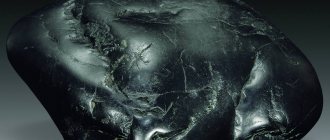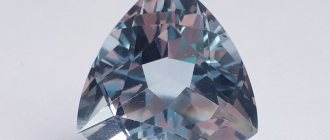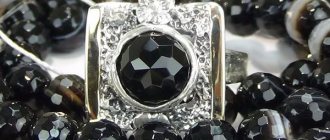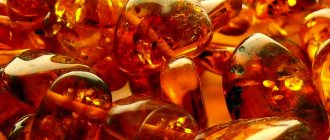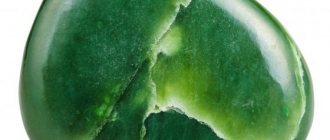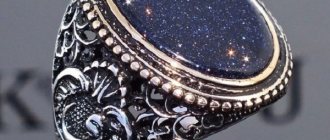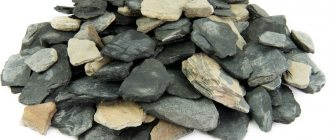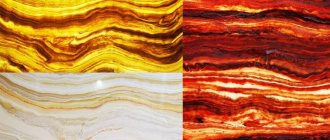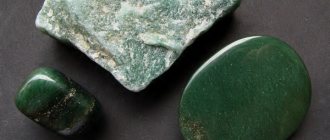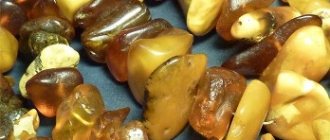| Category | Silicate minerals |
| Title in English | Nephrite |
| Formula | Ca2(Mg,Fe)5[Si4O11]2(OH)2 |
| Group | Amphiboles group |
| Color | Green, White, Gray |
| Stroke color | White |
| Shine | Bold, Glass |
| Transparency | From translucent in chips and plates 1-1.5 cm wide to opaque |
| singonia | Monoclinic |
| Hardness | 6 — 6,5 |
| Cleavage | Absent |
| Density, g/cm³ | 2,9 — 3 |
| Kink | Conchoidal, Paraffin-like |
| origin of name | In order to give the name to the mineral Jade, mineralogists took as a basis two Greek words: nephros, which translates as kidney and λίθος, which in Russian means the word “stone”. |
Jade or kidney stone is a monomineral aggregate that consists of matted fibrous tremolite-actinolite amphibole. A remarkable feature of this mineral is its high viscosity: it is very difficult to split jade. Iron, chromium and manganese, which are part of the mineral, determine its color. The color palette of the gem starts from white, includes various shades of green and ends with black. The rarest and most valuable are blue and red jade samples. Also, plain pieces are valued higher than those decorated with stripes, streaks and other patterns. Jade is widely used as an ornamental stone and a unique mineral in jewelry.
History of jade
— Advertising —
People began using jade back in the Neolithic era. Then it was used in the manufacture of strong weapons and tools, and later it began to be used for jewelry. Jade was especially popular at all times in China. For example, there is a Buddha statue 6 meters high, carved from a single piece of milk jade.
Jade was also popular among other peoples due to its beauty and high strength. Tamerlane's tomb was covered with a black jade slab. The sarcophagus of Tsar Alexander III was also carved from jade.
Today jade is no less popular than in the old days as an ornamental and jewelry stone.
Stone jewelry
Fine jewelry is made from jade: earrings, beads, rings, bracelets. They go well with light pastel shades. Beautiful images are obtained with jade jewelry in combination with romantic dresses and blouses or strict black jackets.
Most often the gem is framed in silver. Moreover, it looks best in frames of unusual intricate shapes.
Read more about jade jewelry in a separate article.
View this post on Instagram
Posted by Dom Astrel (@astrel17) Nov 5, 2021 at 3:23 PST
View this post on Instagram
Posted by Dom Astrel (@astrel17) Jun 29, 2021 at 2:09 PDT
View this post on Instagram
Posted by Dom Astrel (@astrel17) Jun 8, 2021 at 5:25 PDT
Caring for stone and products
Jade is famous for its durability. It retains its attractive appearance for a long time if properly cared for:
- The jewelry is stored in a separate box or in a box with other jewelry in an individual bag. It will not be scratched when interacting with other stones, but it can damage products made from softer gems.
- It is recommended to wash the jewelry after each wear. If the jade is heavily soiled, it is washed with soap and water. After this, the stone is polished with a soft cloth.
The stone is not afraid of direct sunlight and water. It can be worn in the shower and on the beach. It is not necessary to store it in a dark place.
Physico-chemical characteristics of jade
Jade is a sodium and aluminum silicate.
Its crystals are colored in shades of green, gray, yellow, white and black, and rarely blue and red. They are translucent or opaque, without shine and cleavage, with a monoclinic system, splintered at the fracture. They do not have pleochroism. — Advertising —
The hardness of jade on the Mohs scale is 5.5-6.5. Specific gravity 2.8-3.3 g/cm3. Refractive index 1.60-1.65.
An important optical property of jade is its ability to be translucent. The light is scattered within the stone, creating the illusion of a hazy glow. This phenomenon is especially pronounced in light green and blue samples.
The durability of jade crystals is also legendary. Thanks to its fibrous structure, the stone is practically not susceptible to mechanical stress; it is one of the few rocks that are both elastic and durable.
Magical properties of jade
Jade is endowed with powerful energy properties.
The mineral makes its owner soft, fair, striving for knowledge, moderate life, courageous and honest. Thanks to the influence of the stone, happy changes occur in a person’s life, he finds ways out of dead-end situations. Jade is recommended to everyone who longs for change and rethinking of life. Since ancient times, jade has been considered a source of vitality, health and longevity. In the East it was called the “stone of victory” and a strong amulet.
Jade can bring good luck in gambling and is a reliable assistant in financial matters.
The Chinese believed that jade reacted to the behavior of its owner. Cloudiness or darkening of the stone indicated wrong actions.
Which zodiac signs are jade suitable for?
Astrologers recommend wearing jade jewelry for people born under the sign of Virgo and Taurus. They will always be lucky in any endeavor. So, if Taurus wears a jade bracelet on their right hand, then they are guaranteed longevity, and in this case Virgo will experience great family happiness.
In addition, jade can be worn by Aquarius and Gemini.
But it is categorically not recommended for signs of the zodiac of the water element to wear jewelry with jade: Cancers, Scorpios and Pisces can become despondent from the excessive suppressive and stabilizing effect of the stone.
The healing properties of jade
Due to its high heat capacity, jade is a warm and pleasant stone to the touch.
It is often applied to the stomach and kidney area as a compress or heating pad to relieve pain. This is why jade is called "kidney stone" and is considered a good remedy for kidney diseases. In addition, the mineral helps normalize blood pressure, improve the functioning of the lungs and heart, liver and stomach, circulatory system, and improve hearing and vision. In lithotherapy, it is used as a remedy for headaches, dizziness, atherosclerosis, stroke and eye diseases.
Special massage rollers are made from the mineral to relieve headaches, normalize blood pressure, enhance potency, as well as cosmetic massages to eliminate wrinkles and sagging skin. Jade massage stimulates blood circulation and relieves fatigue.
Nowadays, jade pillows, which were widely used in Ancient China, are also very popular.
Jade colors
The color palette of jade is very diverse - from black to white due to the presence of various impurities. The most common jade is green and its shades: marsh, grassy, light green, emerald and yellow-green. Red and blue jade is very rare. The yellow-brown-green variety with a “cat’s eye” effect is also considered unique.
Mining and stone processing
Jade mining is carried out all over the world. There are several large deposits in Russia:
- Sayanskoe;
- Baikal;
- in the Urals;
- Kovyktinskoye in Irkutsk;
- Tsypinskoe;
- In Kazakhstan;
- on Sakhalin;
- in Kamchatka;
- in Tuva.
Russia is rich in jade deposits. The largest deposits of the gem are located in Buryatia. Most of the jade mined in our country is sold to Chinese consumers.
There are also deposits in the USA, China, Mexico, Poland, Myanmar and New Zealand. It is in New Zealand that rare red and blue gems are most often found.
Untreated jade looks dull and unattractive. It is mined in large blocks and pellets.
The found gems are cut into pieces of the required size. After this, they are given the desired shape, ground and polished. In the jewelry industry, such crystals are most often designed in the form of round or faceted beads, cabochons or drops.
How to distinguish real jade from a fake
As an inexpensive stone, jade is rarely counterfeited, but imitations made from glass, clouded with pigments and fibrous structure additives, are still found.
They can be distinguished by the fact that glass is polished to a mirror shine, while jade always retains some dullness, and small defects are visible on its surface.
Prices for jade products
The cost of a processed piece of jade, depending on color and size, ranges from 2-30 dollars.
One of the most expensive is imperial jade, painted in a rich green color and highly transparent.
Cabochon-cut specimens without black inclusions of pure green color are estimated at $30-50.
Meaning and description of the mineral
Jade is an ornamental semi-precious stone. There are many deposits of this mineral, so it can be found at any gem fair. It is a hydrosilicate of magnesium, iron and calcium. It belongs to the amphiboles, so named because of their variable properties.
The raw mineral looks like a regular gray stone with a green, red or pink coating. Only after removing the unremarkable top layer does the full beauty of the gem become noticeable.
It can have different shades (from milky white to almost black). The most common are green and light green specimens. The color of the gem can be either uniform or with blurred lines, spots, eyes and other patterns. The most expensive specimens are plain.
Stones have varying degrees of transparency. If you look through them into the light, you will notice the smoky patterns of amphibole layers inside the gem.
Crystals form when magma flows through rock. In nature, they are found in rivers, quarries and mountains.
The most durable are jades found in water. They are valued higher.
Watch an overview video about the stone:
Varieties and colors
In nature, jades are found in a variety of colors. The price of minerals largely depends on the shade and pattern:
- Blue, blue and red jades are rare. Such specimens look beautiful and unusual. They have a high cost.
- Dark gray, almost black jade. Usually these stones have stripes of different shades of gray. This type of gem is mined at a depth of 900 m at the border of the junction of jade and magnetic ores.
- Purple and lilac stones are very rare. They are found in New Zealand.
- Cat's eye jade is valued in jewelry. It has a light silky sheen and a line in the middle, which creates the effect of a cat's eye. These gems combine yellow, green and brown.
- Green gems. There are both dark green and light green stones. This is the most common type of jade.
- White jades. Valued in China. There are stones of greenish, milky and yellowish shades.
Crystals are divided into types depending on their structure. Specimens with a uniform color are transparent and have a greasy sheen; when held up to light, smoky patterns are visible in them. They are most prized by jewelers.
Gems with multi-colored stripes and spots are usually completely opaque. They are most often used for making interior items.
There is a Chinese classification:
- Khotan. Very appreciated in China. It has a uniform white color with a greasy sheen.
- Xiuyan. Translucent yellow-green gem.
- Lantian. Yellow mineral. Cloudy patterns are characteristic.
- Nanyang. A common type of crystal. Color varies from green to yellow. Opaque, characterized by stripes and pink veins.
The jade pellet is especially interesting. Such stones are found in reservoirs; they acquire a round shape due to the fact that they are ground by water for a long time.
To view a photo gallery with Chinese stones:
Khotan
Xiuyan
Lantian
Nanyang
Interesting facts about jade
- Until the mid-19th century, jade and jade were considered one mineral and were called jade.
- Jade is the national symbol of China, the “stone of life.” It was valued even higher than gold and silver, as the Chinese believed in its powerful magical properties. There was even a saying that “gold has a price, but jade is priceless.” According to archaeological data, the Chinese began using jade about 7000-8000 years ago. Weapons and ritual things were created from it. Chinese philosophers said that jade has five virtues: soft shine - the personification of mercy, strength - moderation and justice, translucency - symbolized honesty, purity - wisdom, changeability - courage.
